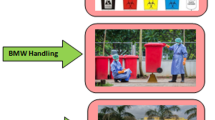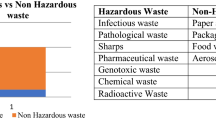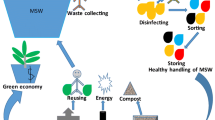Abstract
Ever since the transmission of novel coronavirus through human-to-human hit the world. As this disease is spreading every day, hospitalisation of individuals increased. Consequence of this, there is a sudden surge of millions of gloves, masks, hand sanitizers and the other essential equipment in each month. Disposal of these commodities is a big challenge for hospitals and COVID-centre, as they may became the reason of creating pollution and infect the surroundings. Increasing hospitalisation cases of COVID-19 results in raising bio-waste which creates pollution. Observing the scenario, a mathematical model with four compartments is constructed in this article. The threshold value indicates the intensity of pollution that emerged from bio-waste. Stability of the equilibrium point gave the necessary condition. Optimal control theory is outlined to achieve the purpose of this chapter by reducing pollution. Outcomes are analytically proven and also numerically simulated.
Access provided by Autonomous University of Puebla. Download conference paper PDF
Similar content being viewed by others
Keywords
Mathematics Subject Classification
Introduction
In February 2020, COVID 19 as pandemic globally, the World Health Organization (WHO) stated that this outbreak is highly infectious [1]. Such a contagious and contaminate disease, plastic plays a vital role in making confident social worker to deal with it. As per the latest (2020c) WHO evaluations, the world has consumed 89 million masks, 30 million gowns, 1.59 million goggles, and 76 million gloves per month alone due to the COVID-19 [2]. As these things cannot be reused, it can only be dumped or recycled becomes waste. Thus, along with Personal Protective Equipment (PPEs) and sanitization, this biomedical waste is also a big challenge for any hospital having COVID patients. The waste produced by healthcare taken at home during COVID-19 pandemic time is also classified as bio-waste but this research only includes bio-waste produced due to hospitalisation. As time passed, the disposal of bio-waste creates pollution.
In March 2020, the government of India has released guidelines for handling safe disposal of bio-waste generated during the treatment of a patient having novel coronavirus [3]. In a very short time, the COVID-19 outbreak becomes epidemic in some highly populated regions and it becomes more complicated for doctors to handle the large scale of infected population henceforth, rigorous monitoring may not be possible. If medication guidelines could be followed then transmission of COVID-19 and pollution through bio-waste can also be controlled [4].
Observing each situation, a mathematical model with a system of nonlinear differential equations is illustrated in Sect. Mathematical Modelling. The data collection is done precisely. The data which are not available taken as hypothetically. The formulation of the basic reproduction number gives a significant result of the model that resolves the amount of pollution created from bio-waste. Section Stability includes the stability of equilibrium points of the system. To control pollution, optimal control theory is used and three controls are applied to the system in Sect. Optimal Control. Section Numerical Simulation concludes all results graphically with validated data.
Mathematical Modelling
Transmission of COVID infection is spreading frequently all-around the world. A mathematical model consists four compartments. The first compartment is infected individuals by the coronavirus \(\left( {C_{I} } \right)\) who are getting hospitalised \(\left( H \right)\). Due to hospitalisation, all necessary equipment are used, which increase the density of bio-waste \(\left( {B_{W} } \right)\) and day by day increment contaminates the environment called pollution \(\left( P \right)\).
Dynamics of the model are shown in Fig. 17.1. Parameters that connect each compartment called rates show the flow of the model.
Description and parametric values:
Data is taken on July 23, 2020, 07:55 GMT.
\(B\) = 0.22, growth rate is the ratio of active cases to total cases, i.e. 3,474,060/15,642,265 [5].
\(\beta\) = 0.5760, the rate at which COVID infected individuals are getting hospitalised. Centers for Disease Control and Prevention (CDC) reported that the overall cumulative COVID-19 hospitalisation rate is 113.6 per 1,00,000 [6]. Hence, from this rate, total hospitalised infected individuals are 88,60,741; hence, the rate at which infected individuals are hospitalised is the ratio of the number of hospitalised cases to total infected cases.
\(\mu_{1}\) = 0.6537, is death rate of coronavirus infected individuals. This is the ratio of death cases to total infected cases, i.e. 6,30,370/15,382,854 [5].
\(\mu_{2}\) = 0.0711, is death rate of hospitalised individuals. This is the ratio of death cases to total hospitalisation cases, i.e. 6,30,370/88,60,741 [6].
\(\gamma\) = 0.75, is the rate bio-waste created due to hospitalisation. This data is from different channels suggests that world could generate an entire year’s worth of medical waste in two or three months because of the impact of COVID-19 [7]. It means we can say that there is approximately 0.75% raise is seen in biomedical waste.
\(\varepsilon\) = 0.6 is increasing rate of pollution due to produced bio-waste (data is taken from [8]).
\(\eta\) = 0.3 is the rate at which bio-waste infect the individual.
\(\mu_{4}\) = 0.4 is the escape rate.
Note that \(\mu_{4}\) and \(\eta\) are taken hypothetically considering by current situation of world due to novel corona virus.
By using four compartments which are connected with these parameters mentioned in Sect. Mathematical Modelling, the following system of equations can be generated,
with \(C_{I} > 0\) and \(H,B_{W} ,P \ge 0\).
By accumulating and this initial condition gives the feasible region of the model, \(\Lambda = \left\{ {(C_{I} ,H,B_{W} ,P) \in R^{4} :C_{I} + H + B_{W} + P \le \frac{B}{{\mu_{1} }}} \right\}.\)
Solving system (17.1), two equilibrium points are evaluated. First is pollution-free and another is endemic equilibrium point having optimum value.
-
(i)
\(E_{0} \left( {\frac{B}{{\mu_{1} }},0,0,0} \right)\)
-
(ii)
\(E^{*} \left( {C_{I}^{*} ,H_{{}}^{*} ,B_{W}^{*} ,P^{*} } \right)\)
where \(C_{I}^{*} = \frac{{\gamma_{1} + \mu_{2} }}{\beta }\), \(H^{*} = \frac{{\left( {B\beta - \mu_{1} \left( {\gamma_{1} + \mu_{2} } \right)} \right)\left( {\varepsilon + \eta } \right)}}{{\beta \left( {\varepsilon \gamma_{1} + \mu_{2} \left( {\varepsilon + \eta } \right)} \right)}}\), \(B_{W}^{*} = \frac{{\gamma_{1} \left( {B\beta - \mu_{1} \left( {\gamma_{1} + \mu_{2} } \right)} \right)}}{{\beta \left( {\varepsilon \gamma_{1} + \mu_{2} \left( {\varepsilon + \eta } \right)} \right)}}\) and \(P^{*} = \frac{{\varepsilon \gamma_{1} \left( {B\beta - \mu_{1} \left( {\gamma_{1} + \mu_{2} } \right)} \right)}}{{\beta \mu_{4} \left( {\varepsilon \gamma_{1} + \mu_{2} \left( {\varepsilon + \eta } \right)} \right)}}\).
The threshold value is calculated by using next-generation matrix method called basic reproduction number \(\left( {R_{0} } \right)\) [9].
Calculating Jacobian matrix of \(F\) and \(V\), the mathematical expression of \(R_{0}\) is, \(\frac{B\beta }{{\mu_{1} \left( {\gamma_{1} + \mu_{2} } \right)}}\).
\(R_{0}\) is very important mathematical term for the dynamical model. After substitution of the parameter threshold value suggest that, 23.64% pollution is observed.
Stability
Local Stability
Theorem 1
The pollution-free equilibrium point \(E_{0}\) is locally asymptotically stable if \(B\beta < \mu_{1} \left( {\gamma_{1} + \mu_{2} } \right)\).
Proof
The Jacobian matrix of the system at \(E_{0}\) is derived and eigenvalues of this matrix are:
(i) \(- \mu_{4}\), (ii) \(- \mu_{1}\), (iii) \(- \left( {\varepsilon + \eta } \right)\), (iv) \(\frac{{B\beta - \mu_{1} \left( {\gamma_{1} + \mu_{2} } \right)}}{{\mu_{1} }}\).
Equilibrium point is stable if each eigenvalue of Jacobian matrix at \(E_{0}\) is negative and here it seems that, fourth eigenvalue is positive. Hence, equilibrium point is locally asymptotically stable if \(B\beta < \mu_{1} \left( {\gamma_{1} + \mu_{2} } \right)\).
Theorem 2
The optimum issue point \(E^{*}\) is locally asymptotically stable if \(C_{I} \beta < \min \{ 1,\varepsilon + \eta ,\varepsilon + \eta + \mu_{1} + \mu_{4} \} + \left( {\gamma_{1} + \mu_{2} } \right)\).
Proof
The characteristic equation of the Jacobian matrix at endemic equilibrium point,
where
Using Routh-Hurwitz (1877) [10] criteria, this optimum issue point is globally asymptotically stable if \(C_{I} \beta < \min \{ 1,\varepsilon + \eta ,\varepsilon + \eta + \mu_{1} + \mu_{4} \} + \left( {\gamma_{1} + \mu_{2} } \right)\) condition is satisfied.
Stability analysis advices that if \(\beta\) that is the rate at which infected people getting hospitalised is lesser then model will be stable.
Global Stability
Theorem 3
The pollution-free equilibrium point \(E_{0}\) is globally asymptotically stable whenever \(R_{0} \le 1\).
Proof
Consider Lyapunov’s function, \(L_{0} (t) = \,A_{1} C_{I} (t) + A_{2} H(t)\).
\(\therefore L_{0}^{^{\prime}} (t) = \,A_{1} \left( {B - \beta HC_{I} + \eta B_{W} - \mu_{1} C_{I} } \right) + A_{2} \left( {\beta HC_{I} - \gamma H - \mu_{2} H} \right)\)
\(\therefore L_{0}^{^{\prime}} (t) \le \,\left( {A_{2} \left( {\gamma + \mu_{2} } \right)\left( {\frac{B\beta }{{\left( {\gamma + \mu_{2} } \right)\mu_{1} }} - 1} \right) - \frac{{A_{1} B\beta }}{{\mu_{1} }}} \right)H^{0}\)
\(\therefore L_{0}^{^{\prime}} (t) = \,A_{1} C_{I}^{^{\prime}} (t) + A_{2} H^{^{\prime}} (t)\)
\(\therefore L_{0}^{^{\prime}} (t) \le \,\left( {A_{2} \left( {\gamma + \mu_{2} } \right)\left( {R_{0} - 1} \right) - \frac{{A_{1} B\beta }}{{\mu_{1} }}} \right)H^{0}\)
\(\therefore L_{0}^{^{\prime}} (t) \le 0\) if \(R_{0} \le 1\).
Hence, \(E_{0}\) is globally asymptotically stable if \(R_{0} \le 1\).
Theorem 4
The endemic equilibrium point \(E^{*}\) is globally asymptotically stable if \(\frac{{C_{I} }}{{C_{I}^{*} }} = \frac{H}{{H^{*} }} = \frac{{B_{W} }}{{B_{W}^{*} }} = \frac{P}{{P^{*} }} < 1\).
Proof
Let Lyapunov’s function be, \(L_{1} (t) = \varphi \left( {\frac{{C_{I} }}{{C_{I}^{*} }}} \right) + \varphi \left( {\frac{H}{{H^{*} }}} \right) + \varphi \left( {\frac{{B_{W} }}{{B_{W}^{*} }}} \right) + \varphi \left( {\frac{P}{{P^{*} }}} \right)\).
Such that, \(\varphi \left( x \right) = x - 1 - \ln (x)\,,\,\,x > 0\) is an increasing function.
\(\therefore L_{1}^{^{\prime}} (t) = \left( {1 - \frac{{C_{I}^{*} }}{{C_{I} }}} \right)C_{I}^{^{\prime}} + \left( {1 - \frac{{H^{*} }}{H}} \right)H^{^{\prime}} + \left( {1 - \frac{{B_{W}^{*} }}{{B_{W} }}} \right)B_{W}^{^{\prime}} + \left( {1 - \frac{{P^{*} }}{P}} \right)P^{^{\prime}}\)
\(\begin{aligned} \therefore L_{1}^{'} (t) & = \left( {B - \mu _{1} C_{I}^{*} } \right)\left( {1 - \frac{{C_{I}^{*} }}{{C_{I} }}} \right) - \mu _{2} H^{*} \left( {1 - \frac{{H^{*} }}{H}} \right) - \mu _{4} P^{*} \left( {1 - \frac{{P^{*} }}{P}} \right) \\ & \quad - \beta H^{*} C_{I}^{*} \left( {\frac{{H^{*} }}{H} - \frac{{C_{I}^{*} }}{{C_{I} }}} \right)\,\, - \eta B_{W}^{*} \left( {\frac{{C_{I}^{*} }}{{C_{I} }} - \frac{{B_{W}^{*} }}{{B_{W} }}} \right) \\ & \quad - \varepsilon B_{W}^{*} \left( {\frac{{P^{*} }}{P} - \frac{{B_{W}^{*} }}{{B_{W} }}} \right) - \gamma _{1} H^{*} \left( {\frac{{B_{W}^{*} }}{{B_{W} }} - \frac{{H^{*} }}{H}} \right) \\ \end{aligned}\)
Here, \(L_{1}^{^{\prime}} (t) \le 0\) at \(E^{*}\) that is \(C_{I} = C_{I}^{*}\), \(H = H^{*}\), \(B_{W} = B_{W}^{*}\), \(P = P^{*}\) and \(\frac{{C_{I}^{*} }}{{C_{I} }} = \frac{{H^{*} }}{H} = \frac{{B_{W}^{*} }}{{B_{W} }} = \frac{{P^{*} }}{P} < 1.\) Hence, \(E^{*}\) is globally asymptotically stable.
Optimal Control
Optimal control helps to optimise objective function over a few periods. Three controls are applied to the system. The first control \(\left( {u_{1} } \right)\) is on COVID-19 infected people to optimise hospitalisation. The second control \(\left( {u_{2} } \right)\) is treated on hospitalised individuals which decreases bio-waste and the third control \(\left( {u_{3} } \right)\) is a treatment applied to the bio-waste material that can optimise pollution. Therefore, the system seems,
The objective function is,
where, \(\Lambda\) denotes set of all compartmental variables, \(A_{1} ,A_{2} ,A_{3} ,A_{4}\) denote non-negative weight constants for compartments \(C_{I} ,H,B_{W} ,P\) respectively. \(w_{1} ,w_{2}\) and \(w_{3}\) are the weight constants for each control \(u_{i}\) where \(i = 1,2,3\), respectively.
Compute every values of control variables from \(t = 0\) to \(t = T\) such that,
where \(\phi\) is a smooth function on the interval [0, 1].
The optimal control denoted by \(u_{1} ,u_{2}\) and \(u_{3}\) are found by computing all the integrands of Eq. (17.3) using the lower bounds and upper bounds respectively with the results of Fleming and Rishel [11].
For minimising the cost function in Eq. (17.3), using the Pontryagin principle [12] by constructing Langrangian function consisting of state equations and adjoint variables \(\lambda_{1} ,\lambda_{2} ,\lambda_{3} ,\lambda_{4} ,\lambda_{5}\) as follows:
The adjoint equation variables, \(\lambda_{i} = (\lambda_{1} ,\lambda_{2} ,\lambda_{3} ,\lambda_{4} )\) for the system (2) is calculated by taking partial derivatives of the Langrangian function with respect to each compartment variable.
The necessary conditions for Langrangian function \(L\) to be optimal are
Hence, one can simplify as,
Using Pontryagin max–min principle, the optimum value of each control is given by,
For simulating result, this computation is done in this section analytically.
Numerical Simulation
In this section, results are simulated numerically wherein the parametric values are considered from Sect. Mathematical Modelling.
Figure 17.2 shows the compartmental behaviour of the model. COVID-19 is spreading day by day. COVID-infected individuals are getting hospitalised, and this interprets that, after approximately one-week bio-waste generated during the pandemic. This collection of bio-waste creates pollution after three and a half weeks if there is not taken any solution to prevent this thing by waste management.
The figure depicts the directional behaviour of bio-waste (Fig. 17.3a) and hospitalised individuals (Fig. 17.3b) towards emerging pollution. As hospitalisation increases, medical staff has to use safety things for protection and hence tons of bio-waste have been produced in each month which increases pollution.
The direction of growth rate (Fig. 17.4a) and hospitalisation rate (Fig. 17.4b) with the basic reproduction number are plotted. Both figures illustrate that the threshold value increases with an increase in both the parametric values. These parameters are more sensitive to the threshold value and hence the model. Other parameters have negligible effect. Therefore, if both parameters have been undertaken care which means that infected people are getting cured by only home isolation then hospitalisation reduce which causes a decrease in pollution.
Three controls are applied to the system as mentioned in Sect. Optimal Control. One can inspects that if 21.7% hospitalisation (Fig. 17.5a) of COVID-infected people decreases then 15.56% of bio-waste (Fig. 17.5b) reduces from the medical sector which results in a reduction of 35.07% in pollution (Fig. 17.5c). This study advocates that control \(u_{1}\) can be performed if individuals follow basic rules and regulation during this pandemic situation. During hospitalisation control \(u_{2}\) is applicable if some changes have been taken care of COVID-19-infected people. General waste does not contaminate the environmental things hence control \(u_{3}\) is beneficial when bio-waste is analysed and also obeys government guidelines.
Figure 17.6 interprets the area-wise distribution of three compartments; hospitalised individuals, bio-waste and pollution created by bio-waste, where the area of respective compartment shows its intensity. Analysis of intensity distribution of the respective compartment shows that, increasing hospitalised cases leads to an increase in bio-waste which accelerates the intensity of pollution.
Result of Fig. 17.7 illustrates that, after getting hospitalisation of infected by coronavirus produces bio-waste which creates pollution. Here, black colour shows that, the everything becomes chaos and this scenario definitely a part of causing pollution.
Conclusion
This study highlights how pollution due to bio-waste is regulated. Due to its adverse effect on human health, many organisations around the world are working in this direction during the current pandemic time. In an account of that, the compartmental model has been developed using some affected parameters and the data for simulation is taken from a recent ongoing COVID-19 outbreak. By solving the system, two equilibrium points are evaluated and both of them are stabilised locally and globally. The calculated threshold value suggests that 23.64% of pollution is created from biomedical waste from hospitalisation during the COVID-19 outbreak. This analysis recommends that if the rate at which infected people getting hospitalised is lesser, then this bio-waste is controlled and that reduces the pollution. Optimal control theory advices that, this bio-waste is started with having an infection coronavirus. Everyone has to get over it. Simulation suggests the reduction of pollution by 35.07%. Heartfelt thanks to all corona warriors. Its our prime duty to follow rules to fight again this contagious coronavirus and can contribute to make planet pollution-free and healthier.
References
Sohrabi, C., Alsafi, Z., O’Neill, N., Khan, M., Kerwan, A., Al-Jabir, A., et al. (2020). World Health Organization declares global emergency: A review of the 2019 novel coronavirus (COVID-19). International Journal of Surgery, 71–76.
Mahanwar, P. A., & Bhatnagar, M. P. (2020). Medical Plastics Waste.
https://qz.com/india/1824884/india-frames-rules-for-disposing-coronavirus-waste-from-hospitals/.
Ranjan, M. R., Tripathi, A., & Sharma, G. (2020). Medical waste generation during COVID-19 (SARS-CoV-2) pandemic and Its management: An Indian perspective. Asian Journal of Environment & Ecology, 10–15.
https://www.cdc.gov/coronavirus/2019-ncov/covid-data/covidview/index.html.
Sharma, H. B., Vanapalli, K. R., Cheela, V. S., Ranjan, V. P., Jaglan, A. K., Dubey, B., et al. (2020). Challenges, opportunities, and innovations for effective solid waste management during and post COVID-19 pandemic. Resources, Conservation and Recycling, 105052.
Diekmann, O., Heesterbeek, J. A. P., & Metz, J. A. (1990). On the definition and the computation of the basic reproduction ratio R0 in models for infectious diseases in heterogeneous populations. Journal of Mathematical Biology, 28(4), 365–382.
Routh, E. J. (1877). A treatise on the stability of a given state of motion: Particularly steady motion. Macmillan and Company.
Fleming, W., & Lions, P. L. (Eds.). (2012). Stochastic differential systems, stochastic control theory and applications. In Proceedings of a Workshop, held at IMA, June 9–19, 1986 (Vol. 10). Springer Science & Business Media.
Pontryagin, L. S., Boltyanskii, V. G., Gamkrelidze, R. V., & Mishchenko, E. F. (1986). The mathematical theory of optimal process (pp. 4–5). New York: Gordon and Breach Science Publishers.
Acknowledgements
The authors thank reviewers for their constructive comments. All authors are thankful to DST-FIST file # MSI-097 for technical support to the department of Gujarat University. Second author (ENJ) is funded by UGC granted National Fellowship for Other Backward Classes (NFO-2018-19-OBC-GUJ-71790). Third author (PMP) is funded a scholarship by Education Department, Gujarat State for providing scholarship under ScHeme Of Developing High quality research (student AisheCode: 201901380135).
Author information
Authors and Affiliations
Corresponding author
Editor information
Editors and Affiliations
Rights and permissions
Copyright information
© 2021 The Author(s), under exclusive license to Springer Nature Singapore Pte Ltd.
About this paper
Cite this paper
Shah, N.H., Jayswal, E.N., Pandya, P.M. (2021). Bio-waste Management During COVID-19. In: Shah, N.H., Mittal, M. (eds) Mathematical Analysis for Transmission of COVID-19. Mathematical Engineering. Springer, Singapore. https://doi.org/10.1007/978-981-33-6264-2_17
Download citation
DOI: https://doi.org/10.1007/978-981-33-6264-2_17
Published:
Publisher Name: Springer, Singapore
Print ISBN: 978-981-33-6263-5
Online ISBN: 978-981-33-6264-2
eBook Packages: EngineeringEngineering (R0)











